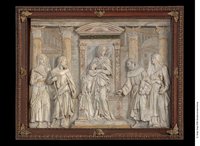Die Kamee in den Farben weißblau und braun zeigt eine Darstellung des Guten Hirten. Er trägt mit beiden Händen ein Lamm über seinen Schultern. Sein braunes, gegürtetes Gewand fällt von seiner linken Schulter herab und lässt die rechte Schulter frei. Die Fassung der Kamee ist modern. Sie ist mit Kreuzen auf dem Ring verziert.
(Cäcilia Fluck, März 2017)
Entstehungsort stilistisch: Weströmisches Reich
en

